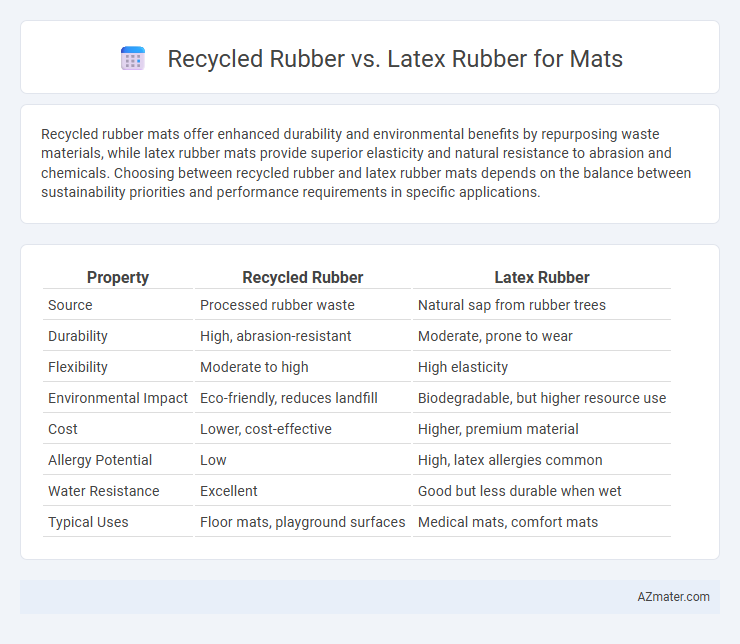Recycled rubber mats offer enhanced durability and environmental benefits by repurposing waste materials, while latex rubber mats provide superior elasticity and natural resistance to abrasion and chemicals. Choosing between recycled rubber and latex rubber mats depends on the balance between sustainability priorities and performance requirements in specific applications.
Table of Comparison
| Property | Recycled Rubber | Latex Rubber |
|---|---|---|
| Source | Processed rubber waste | Natural sap from rubber trees |
| Durability | High, abrasion-resistant | Moderate, prone to wear |
| Flexibility | Moderate to high | High elasticity |
| Environmental Impact | Eco-friendly, reduces landfill | Biodegradable, but higher resource use |
| Cost | Lower, cost-effective | Higher, premium material |
| Allergy Potential | Low | High, latex allergies common |
| Water Resistance | Excellent | Good but less durable when wet |
| Typical Uses | Floor mats, playground surfaces | Medical mats, comfort mats |
Introduction to Recycled Rubber and Latex Rubber Mats
Recycled rubber mats are made from repurposed rubber materials, offering durability, eco-friendliness, and resistance to wear, making them ideal for heavy-duty applications like gym flooring and playground surfaces. Latex rubber mats, derived from natural rubber sap, provide excellent elasticity, softness, and cushioning, suitable for yoga mats and anti-fatigue flooring. Both types serve unique purposes, with recycled rubber mats emphasizing sustainability and robustness, while latex mats prioritize comfort and flexibility.
Material Sources: Recycled vs. Natural Latex Rubber
Recycled rubber mats are produced from repurposed tires and industrial rubber waste, offering an eco-friendly alternative by reducing landfill material and resource consumption. Natural latex rubber mats derive from the sap of rubber trees (Hevea brasiliensis), providing a renewable, biodegradable source with inherent elasticity and resilience. Choosing between recycled and natural latex rubber depends on environmental impact priorities, durability requirements, and allergy considerations related to natural latex proteins.
Environmental Impact Comparison
Recycled rubber mats significantly reduce landfill waste by repurposing scrap tires, lowering the demand for virgin materials and minimizing environmental pollution. Latex rubber, derived from natural rubber trees, offers biodegradability but involves intensive agricultural practices that can lead to deforestation and high water usage. Choosing recycled rubber mats supports circular economy principles by utilizing post-consumer waste, while latex mats prioritize renewable resources with trade-offs in ecological land use.
Durability and Longevity of Each Material
Recycled rubber mats offer exceptional durability due to their dense composition and resistance to wear, making them ideal for high-traffic areas with heavy use. Latex rubber mats provide excellent elasticity and resistance to cracking, but they may degrade faster under prolonged exposure to UV light and heavy abrasion compared to recycled rubber. Overall, recycled rubber mats tend to have a longer lifespan and superior toughness, making them more suitable for environments demanding sustained durability.
Texture, Grip, and Performance
Recycled rubber mats offer a dense, coarse texture that enhances grip through its rugged surface, making them ideal for heavy-duty flooring applications requiring durability and slip resistance. Latex rubber mats provide a smoother, more elastic texture that conforms better to surfaces, delivering superior grip via natural tackiness and flexibility, which is beneficial for yoga or fitness mats focused on comfort and performance. Performance-wise, recycled rubber excels in longevity and environmental sustainability, while latex rubber outperforms in cushioning, resilience, and tactile responsiveness for dynamic movements.
Health and Safety Considerations
Recycled rubber mats often contain synthetic additives and residual contaminants that can emit volatile organic compounds (VOCs), posing potential respiratory risks especially in poorly ventilated areas. Latex rubber mats, derived from natural latex, offer hypoallergenic properties but may trigger allergic reactions in sensitive individuals due to natural proteins. Selecting mats with certified low VOC emissions and allergen-free labeling enhances health and safety compliance in both residential and commercial environments.
Cost Analysis: Recycled Rubber vs. Latex Rubber Mats
Recycled rubber mats generally offer a more cost-effective solution compared to latex rubber mats due to lower raw material and manufacturing expenses. Latex rubber mats tend to have higher initial costs driven by natural latex sourcing and processing complexities, yet may offer superior elasticity and comfort. Evaluating long-term durability and maintenance costs is essential, as recycled rubber mats often provide better wear resistance, resulting in lower replacement frequency and overall savings.
Maintenance and Cleaning Requirements
Recycled rubber mats require minimal maintenance, often needing only regular sweeping and occasional hosing to remove dirt and debris, making them highly durable and resistant to moisture and mold. Latex rubber mats demand more frequent cleaning with mild soap and water to prevent deterioration and maintain elasticity, as they are more susceptible to damage from oils and harsh chemicals. Both materials benefit from avoiding prolonged exposure to direct sunlight to extend their lifespan and preserve their cleaning ease.
Hypoallergenic and Allergen Risks
Recycled rubber mats often contain residual chemicals and contaminants that can trigger allergic reactions, making them less suitable for individuals with sensitivities. Latex rubber mats are naturally hypoallergenic due to their pure rubber composition but can cause latex allergies in susceptible people. Opting for high-quality, specifically treated latex mats reduces allergen risks compared to recycled rubber alternatives.
Sustainability and Eco-Friendliness
Recycled rubber mats significantly reduce landfill waste by repurposing used tires, enhancing sustainability through resource conservation and lower carbon footprints compared to virgin materials. Latex rubber, while biodegradable and natural, involves agricultural resource consumption and may contribute to deforestation and pesticide use, impacting eco-friendliness. Choosing recycled rubber prioritizes circular economy principles and waste reduction, making it a greener option for environmentally conscious consumers.

Infographic: Recycled rubber vs Latex rubber for Mat
 azmater.com
azmater.com